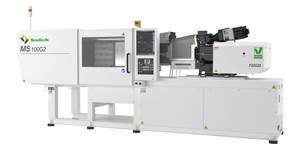For Repeatable Molding, Add Some Variability
Engel finds repeatability in a variable process.
The contrast in the two images couldn’t be more stark. On the left, bars marking screw position run jagged, lengthening and shortening the whole way down. On the right, a perfectly straight line can be drawn down the corresponding short shots molded from those varied screw positions.
Joachim Kragl, director of advanced injection molding systems at injection molding and automation supplier , explained the dichotomy between the images at Engel’s recent symposium at its Corona, Calif. technical center, but first he had a question for his audience.
“It’s 2015; all-electric injection molding machines offer precision, but we still get short shots, we still get flash—why?” Kragl asked.
Why indeed; if servo motors can ensure screws travel the virtually same path on every shot, down to the micron, how are different amounts of material injected into the mold?
To answer the question, Engel took an all-electric press and measured the repeatability of its stroke. It found variations of ± 3 µm on stop and ± 10 µm in start positions, which would theoretically result in a variation of .009g in part weight. In reality, however, the shot-to-shot weight variation ranged up to .011g.
Potential culprits are numerous—slippage of check ring on the machine side—with variations in material viscosity playing a role. Those viscosity changes could derive from multiple factors, ranging from inadequate material drying to the presence of regrind to lot-to-lot inconsistencies in resin.
Accepting some variation as an inevitability, Engel sought the best outcome by treating the symptoms of the malady, namely short shots and flash. The answer has been its iQ weight control software, which tracks the changes as they occur and varies the screw position in real time to get the closest to the desired shot volume. (You can read more about the software here).
In practice, the software looks at injection pressure vs. screw stroke, taking a reference pressure curve and splitting it into three areas:
- Volume variation (as the check ring closes)
- Changes in viscosity
- Conformance of pressure profile
The result: molders have been able to reduce shot weight variation by up to 85%, according to Engel, with the biggest potential improvements coming in thin-wall parts. “We tackle the viscosity as well as the volume variation,” Kragl explained after his presentation, noting that dealing with both variables heightens iQ’s effectiveness and is possible because the machine maker can “grab data directly in the machine.”
‘No flipping way!’
Nearly three years since its launch, the technology has seen increasing adoption, according to Kragl, albeit more so in Europe than North America. The fact that it creates a repeatable process by varying that process shot to shot has met some resistance, however.
“If you tell someone your cutover point will not be constant and you don’t want it to be constant, they’d just be shocked because that’s what they point the process toward,” Kragl explained. “It’s got to be a repeatable process and position. We say, ‘You know what? Forget that. In order to make your part consistent, this will move,’ and that scares a lot of people.”
In particular, it scares quality folks in industries like automotive and medical, where meticulous documentation of set-in-stone processes is mandatory. “In most of these discussions, first with the processing guys, they’re like, ‘That’s pretty cool and then next we talk to the quality manager, and they’re like, ‘Hey, no flipping way!’” Kragl said with a laugh. “Part of it is actually finding means to kind of make them feel comfortable, let them know if [the process] changes you get a higher quality part.”
One molder, one shot at a time, it seems Kragl and Engel are winning converts.

Related Content
Medical and Molding Elite
When Jeff Smith received a notice evicting his promising 大象传媒 out of his house, it could have been the end of Elite Biomedical Solutions’ and Elite Precision Plastics’ stories before they really got started, instead it was just the beginning.
Read MoreNext-Generation All-Electric and Vertical Injection Molding Machines
Sodick Plustech’s VR-G and MS-G2 Series both utilize the company’s proprietary V-Line technology, separating plasticizing and injection functions, and have upgraded displays, energy efficiency, response time and more.
Read MoreConsistent Shots for Consistent Shots
An integral supplier in the effort to fast-track COVID-19 vaccine deployment, Retractable Technologies turned to Arburg and its PressurePilot technology to help deliver more than 500 million syringes during the pandemic.
Read MoreHaitian Develops Special Edition JU, MA Series for Increased Energy Savings
These models are designed to enable molders to select the right performance level for their needs with the same energy savings but at a lower cost.
Read MoreRead Next
For PLASTICS' CEO Seaholm, NPE to Shine Light on Sustainability Successes
With advocacy, communication and sustainability as three main pillars, Seaholm leads a trade association to NPE that ‘is more active today than we have ever been.’
Read MoreSee Recyclers Close the Loop on Trade Show Production Scrap at NPE2024
A collaboration between show organizer PLASTICS, recycler CPR and size reduction experts WEIMA and Conair recovered and recycled all production scrap at NPE2024.
Read More













